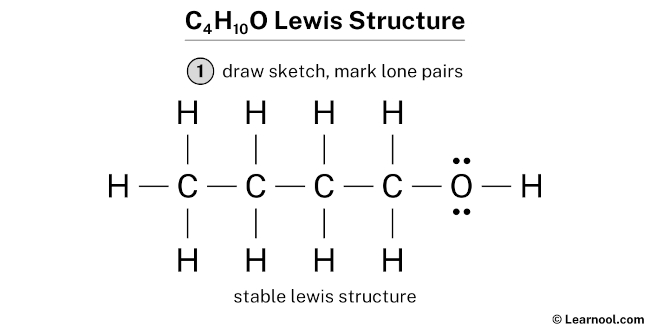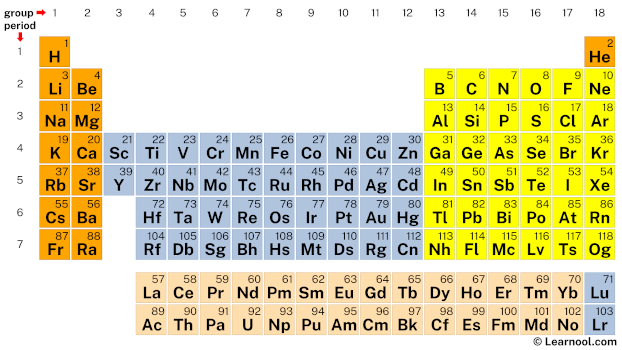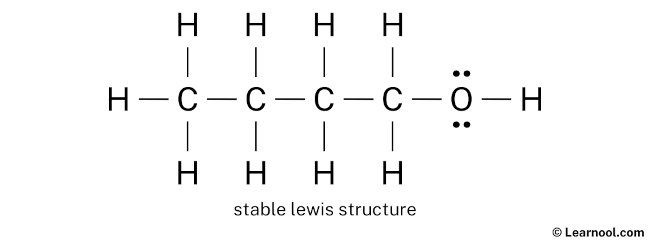
C4H10O or C4H9OH (1-butanol) has four carbon atoms, ten hydrogen atoms, and one oxygen atom.
In C4H10O Lewis structure, there are three single bonds between the four carbon atoms. The first carbon is attached with three hydrogen atoms, second and third carbon is attached with two hydrogen atoms, and the fourth carbon is attached with two hydrogen atoms and one oxygen atom. And the oxygen atom (with which one other hydrogen atom is attached) has two lone pairs.
Alternative method: Lewis structure of C4H10O
Rough sketch
- First, determine the total number of valence electrons

In the periodic table, carbon lies in group 14, hydrogen lies in group 1, and oxygen lies in group 16.
Hence, carbon has four valence electrons, hydrogen has one valence electron, and oxygen has six electrons.
Since C4H10O has four carbon atoms, ten hydrogen atoms, and one oxygen atom, so…
Valence electrons of four carbon atoms = 4 × 4 = 16
Valence electrons of ten hydrogen atoms = 1 × 10 = 10
Valence electrons of one oxygen atom = 6 × 1 = 6
And the total valence electrons = 16 + 10 + 6 = 32
Learn how to find: Carbon valence electrons, Hydrogen valence electrons, and Oxygen valence electrons
- Second, find the total electron pairs
We have a total of 32 valence electrons. And when we divide this value by two, we get the value of total electron pairs.
Total electron pairs = total valence electrons ÷ 2
So the total electron pairs = 32 ÷ 2 = 16
- Third, determine the central atom
Here hydrogen can not be the central atom. Because the central atom is bonded with at least two other atoms, and hydrogen has only one electron in its last shell, so it can not make more than one bond.
Now we have to choose the central atom from carbon and oxygen. Place the least electronegative atom at the center.
Since carbon is less electronegative than oxygen, assume that the central atom is carbon.
Here, there are four carbon atoms, so we can assume any one as the central atom.
Let’s assume that the central atom is first carbon.
Therefore, place carbons in the center and hydrogen and oxygen on either side.
- And finally, draw the rough sketch

Lone pair
Here, we have a total of 16 electron pairs. And fourteen bonds are already marked. So we have to only mark the remaining two electron pairs as lone pairs on the sketch.
Also remember that both (carbon and oxygen) are the period 2 elements, so they can not keep more than 8 electrons in their last shell. And hydrogen is a period 1 element, so it can not keep more than 2 electrons in its last shell.
Always start to mark the lone pairs from outside atoms. Here, the outside atoms are hydrogens, oxygen, second carbon, third carbon, and fourth carbon. But no need to mark on hydrogen, because each hydrogen has already two electrons.
So for oxygen, there are two lone pairs, for other carbons, there is zero lone pair because all electron pairs are over.
Mark the lone pairs on the sketch as follows:

Formal charge
Use the following formula to calculate the formal charges on atoms:
Formal charge = valence electrons – nonbonding electrons – ½ bonding electrons
For each carbon atom, formal charge = 4 – 0 – ½ (8) = 0
For each hydrogen atom, formal charge = 1 – 0 – ½ (2) = 0
For oxygen atom, formal charge = 6 – 4 – ½ (4) = 0
Here, the atoms do not have charges, so no need to mark the charges.
Final structure
The final structure of C4H10O (specifically 1-butanol) features a four-carbon chain where the terminal carbon is linked to an oxygen atom via a single covalent bond, which in turn is bonded to a hydrogen atom. In this arrangement, all four carbon atoms satisfy the octet rule by forming four single bonds each, while the oxygen atom fulfills its octet by forming two single bonds and retaining two lone pairs. Each hydrogen atom in the molecule reaches its stable duet state through its single shared electron pair. This configuration is the most stable because it results in formal charges of zero for all atoms involved, representing the most energetically favorable state for the molecule. Consequently, this specific electronic distribution serves as the definitive and most accurate Lewis representation of n-butanol.
Next: CCl3– Lewis structure
Deep
Learnool.com was founded by Deep Rana, who is a mechanical engineer by profession and a blogger by passion. He has a good conceptual knowledge on different educational topics and he provides the same on this website. He loves to learn something new everyday and believes that the best utilization of free time is developing a new skill.
